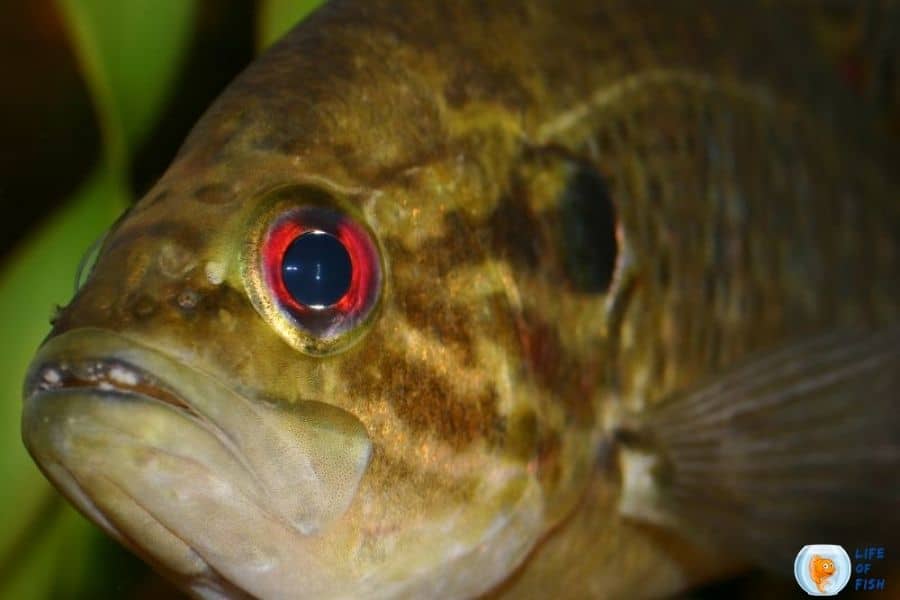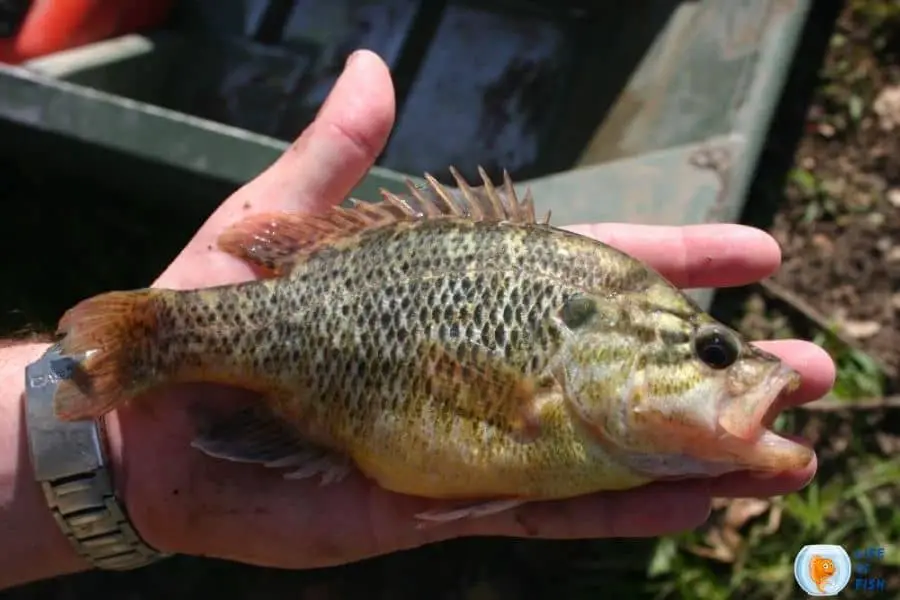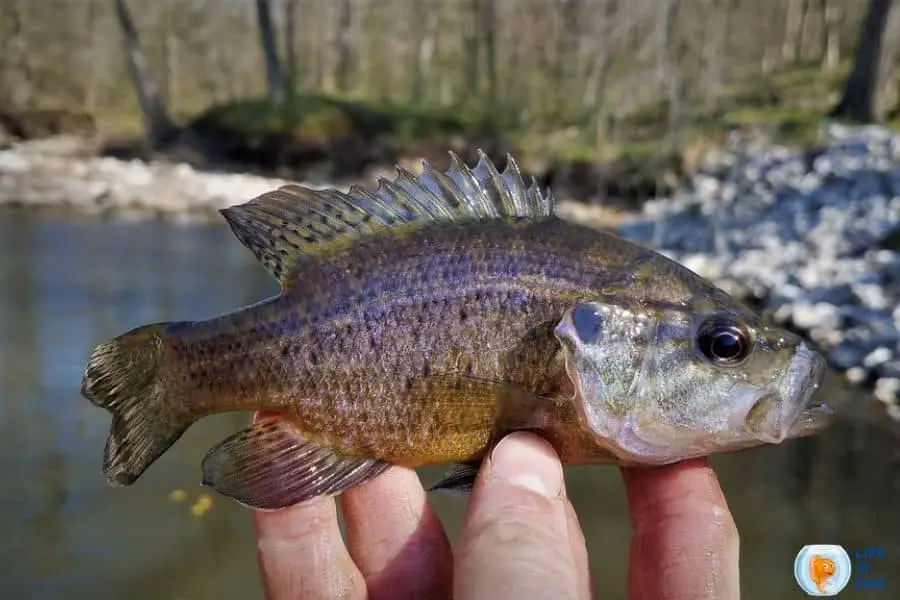Warmouth Bass, commonly called Warmouth fish, Redeye, Goggle-Eye, Mudgapper, Red-Eye Bream, and many other names, is a fish species that belong to the sunfish (Centrarchidae) family.
Warmouth fish are not much sought-after fish like Largemouth Bass because of their small size and bony flesh.
But, anglers like these fish because they hit hard and are easily caught. This article will discuss Warmouth Bass’s physical appearance, habitat, diet, and where to catch one.

What is Warmouth Bass?
Jump To
- 1 What is Warmouth Bass?
- 2 How Warmouth Bass looks like
- 3 Where Warmouth Bass live?
- 4 Warmouth Bass behavior
- 5 What does Warmouth Bass eat?
- 6 Warmouth Bass breeding
- 7 Importance of Warmouth Bass
- 8 Warmouth Bass vs. Rock Bass
- 9 What kind of fish is a Warmouth Bass?
- 10 Is Warmouth Bass rare?
- 11 Is Warmouth Bass poisonous?
- 12 Can you eat Warmouth Bass?
- 13 What is a Warmouth Fishing Season?
- 14 Biggest Warmouth Bass ever caught
- 15 Conclusion
Scientifically named Lepomis gulosus, Warmouth bass is a freshwater fish of the family Centrarchidae (sunfishes).
Warmouth bass is one of the most popular members of the sunfish family, and they are known for their resiliency and hardiness.
Warmouth is native to North America and can be found in lakes or sluggish streams of all sizes, from smaller ponds to large lakes.
It usually lives on the bottom of a body of water with a sandy or gravelly bottom. They typically inhabit areas with lots of aquatic vegetation where they can find shelter.
Many warmouth-inhabited lakes in the United States are visited by anglers every year to catch this fish.
Warmouth is different from other sunfishes because of its large mouth with reddish-brown lines and streaks around mouth and eyes, which has given it many nicknames, including Goggle-eye, Red-eye bream, and Redeye.
The average size of a Warmouth bass is about 7 to 11 inches (18-28cm). The maximum length they can reach is 19 inches (48cm) and weight up to 1.5 lbs (0.7 kg).
Although bigger, these fish are rarely seen because larger species like Bluegill and sunfish usually predate them.
How Warmouth Bass looks like
Color
Warmouths has a dark-colored body with small brown spots. The back, the side of its body, and tail are dark brown.
The belly is lighter than other parts of the body, often with golden color. There is also a reddish-brown area with three to five streaks around the eye called “Redeye,” which has given this fish another nickname, Red-eye bream.
Males have a distinct orange patch at the base of their dorsal fin, and the gill flaps have red tints.
Shape
The shape of the Warmouth is more like a Bass or a bream. It has a large mouth and a rounded tail.
The body of Warmouth is mostly flat and thicker with a large head in which the eyes are very prominent.
The shape of the fish’s eye makes it easy to recognize from other species because it gives this fish its particular name, goggle-eye.
The anal fin has three spines, the dorsal fin has ten spines, and the tongue has tiny teeth. Further, the dorsal and anal fins have brownish spots and bands.
Warmouth fish body is more bass shaped than other sunfish like green sunfish.
Size
Warmouth Bass fish range in size of about 4 to 10 inches (10-25.4cm), although there are some bigger ones as long as 12 inches.
Life span
Warmouth bass has a similar life span as other freshwater sunfishes. They live about eight years, and their maximum age is 13 years old.
Male and female fish
Female and Male fish have distinct differences. Male Warmouths grow bigger than females and have a bright orange spot on their dorsal fin.
Where Warmouth Bass live?
The Warmouth bass is mainly found in North America, especially in lakes or sluggish streams and Mississippi river basins.
It inhabits the southeastern United States, ranging from Florida to Texas and Atlantic and Gulf drainages.
The northern-most range of this fish is New Hampshire, and it has been introduced to many rivers in Canada.
In the United States, Warmouth fish inhabits swamps, marshes, oxbow lakes, or slow-moving streams with a sandy, muddy or gravelly bottom.
The optimum water temperature for this fish is between 70 and 77 degrees Fahrenheit (21 to 25 degrees Celsius).
You can find them in shallow waters when the water is warm, usually in mud or sand.
In colder seasons, Warmouth bass hides deep in the water and move to warmer areas during the spring and summer.
The preferred pH of the water is between 6 and 8, and the acidity is neutral (pH 7). They require at least 3.6ppm oxygen levels in the water to thrive.
Warmouth Bass behavior
Warmouths are diurnal species that stay active during the daytime. They are carnivorous and said to be very aggressive eaters.
They mainly prey on other fish, insects, and small mollusks. Warmouth Basses are ambush predators that lie and wait until their prey comes near them.
Warmouth bass is usually found in shallow waters with a muddy or sandy bottom.
They prefer to stay under the water’s surface, but they will go on top of the water when it’s hot and stay in the shade when it’s cold.
They are generally peaceful with other fish except during nesting. The male fish become aggressive during nesting and spawning.
Young warmouths prefer to stay in the mud or sand near the shoreline of lakes and rivers where they can hide when there is danger.
Adults like to stay in shallower water with ample vegetation than the young.
Warmouths are non-migratory fish. So, they will stay in the same habitat range for years. They are solitary fish and will not stay in groups.

What does Warmouth Bass eat?
Warmouth basses are carnivore fish that are primarily piscivores. They will eat other small fishes, insects, and small mollusks.
Warmouths are bottom feeders that generally prey on invertebrates, including mollusks, insects, and insect larvae. They mainly feed in the early morning are rarely feed at other times.
At the larval stage, these fish feed on small crustaceans like copepods, cladocerans, and ostracods. Juvenile warmouths mainly feed on crayfish, small fish, and mayflies.
In warm water conditions, warmouths may consume up to 4% of their body weight in food every day.
Warmouth Bass breeding
Warmouth basses are solitary nesters and do not spawn in colonies. They build their own nests and guard the young until they are strong enough to survive on their own.
The male Warmouth builds its nest in shallow water and surrounds it with mounds of gravel or rocks. The nests are often built near densely vegetated areas and close to the shoreline.
When the male and female fish get together, they perform an intense mating ritual.
When Warmouths are ready to spawn, the body color of the male fish turns yellow, and his eye color turns bright red.
After they spawn, the breeding pair swim together on the nest. The female fish will release up to 63200 eggs in one spawning session.
The eggs of Warmouth are sticky and yellowish to greenish in color. The male Warmouth will guard them until they hatch.
The eggs will hatch after 2 to 5 days, and the male fish will protect young fish until they can find their food and start to swim away by themselves.
Warmouth babies grow at a rate of 38mm per year, and it takes around one to two years for them to sexually mature.
Importance of Warmouth Bass
Ecosystem balance
Warmouths are secondary predators that help keep the balance in their ecosystem. They prey on small invertebrates and insect larvae like copepods, cladocerans, ostracods, mayfly larvae, and others.
Warmouths will eat much small fish, which helps control the population of some invasive species. They also act as prey for some larger fish .
Sportfishing
Warmouth is considered a highly prized sport fish, which makes it an important game species.
Most anglers deem the Warmouth desirable as a game fish because of its small size and abundance in many habitats.
Anglers also prize Warmouths for their fighting ability when hooked and because they can put up a fight for a long time.
Warmouths can be caught with light fishing rods using worms, insects, bread balls, crickets, or small fish pieces as bait.
As a food
The Warmouth is not considered an excellent food fish if it is caught in polluted or muddy waters.
These fish can tolerate a wide range of water conditions, including dirty or contaminated waters.
If caught from these areas, the flesh will not be tasty. However, if caught from clean water, it will have an excellent taste.
Therefore, it is vital to catch only from pure and clean water. Warmouth has a taste and texture similar to Largemouth bass and Bluegill.

Warmouth Bass vs. Rock Bass
Warmouth bass and Rock Bass are the two most popular panfish species in the USA. Because of their similar appearance, anglers often get confused with one another.
These two fish species have many similarities, including:
They are about the same size. They can both live for up to 4 years old. Both species eat worms, small insects, and mollusks. They live in a home range of about 1 acre.
However, both species have some differences in their appearance, habitats, distribution, and behavior patterns.
Appearance
- Warmouth bass has 3 to 5 dark lines and streaks around the mouth and the eye. But Rock bass lacks the lines and has mottled olive color around the eye.
- Warmouth Bass has ten dorsal spines, whereas rock bass has 11 to 13 dorsal spines
- Warmouths has only three anal fin spines, but Rock Bass has 5 to 7 anal fin spines
- Well grown Warmouth is somewhat larger than a well-grown Rock Bass
Habitats
Warmouths mostly live around vegetated slow to no moving waters. They are often found in woody areas like fallen trees and stumps. You can find them in swamps and natural lakes.
Rock Bass often inhabits flowing waters such as drains, creeks, and large rivers. You may not find them in lakes, ponds, and swamps like Warmouths.
These fish prefer rocky areas such as gravel beds, rock walls, and stone ledges.
Distribution
Warmouth basses are well distributed around the USA and most commonly found in the southeast and the south-central United States.
You can often find them in Great Lakes, Mississippi River Basin, Western Pennisula, Minnesota, and also in the Gulf of Mexico.
Rock Bass has a limited distribution than Warmouth bass. It is native to the midwest and the northeastern United States.
You can often find them in the Mississippi River drainage basin, Great Lakes, Lake Champlain, and the Delaware and Connecticut rivers.
Behavior
- Warmouth basses only feed on early in the morning, while rock basses feed in the mornings and at night.
- Warmouth bass can tolerate much colder water temperatures than Rock Bass.
- Rock Bass are shy by nature, but Warmouth is bolder.
Related Question
What kind of fish is a Warmouth Bass?
Warmouth is one member of the Sunfish family that is native to the United States.
They are closely related to rock bass and share some common names, but they have different physical traits, habitats, and diets.
Is Warmouth Bass rare?
Warmouth Bass are not rare and have a stable population that is not in danger of extinction.
They are widely spread and common in the United States. Therefore, they are listed as Least Concern in the IUCN Red Label list.
Is Warmouth Bass poisonous?
Warmouths are not poisonous, and they are safe to eat.
However, if you catch Warmouth from any muddy or polluted water, the flesh may taste bad, and it is not suggested to eat it.
Can you eat Warmouth Bass?
Yes. You can safely eat Warmouth Bass and even enjoy the taste. The flesh has a good flavor and texture similar to Largemouth bass and Bluegill.
However, if you catch it from polluted or muddy waters, the meat may taste bad.
What is a Warmouth Fishing Season?
The warmouth fishing season in most states runs from April 1 to September 15.
However, it varies depending on the location and water body where you will fish for Warmouth Bass.
Biggest Warmouth Bass ever caught
The world record holds a Warmouth caught in Guess Lake (Yellow River) in Florida in 1985. The fish weighed about 2 pounds and 7 ounces at that time.
Conclusion
Although not popular as Largemouth Bass, Warmouth basses are also famous in Sportfishing because they are hard fighters and can reach a maximum bodyweight of up to 3 pounds.
Because of their smaller size, they are easy to catch, and anglers like catching them for sport. They can be caught from Lakes, ponds, rivers, and streams at any time of the year.
In addition to that, their flesh is edible and has a taste similar to Largemouth bass and Bluegill.
Whether you are a Sportfisherman or just a culinary enthusiast, Warmouth bass should always be on your list of fish to catch.
Read Next : Florida Mudfish | 13 Interesting Facts About A Unfamous Fish |
